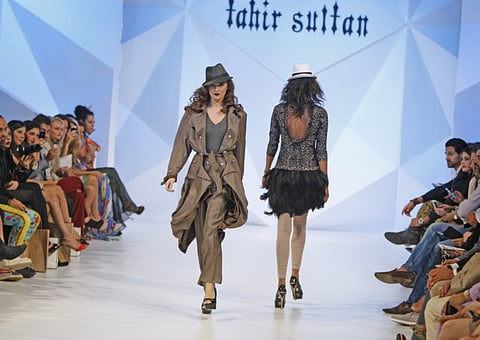Fashion Forward Day 1 gets off to glittering start
The first day of the four-day fashion showcase saw the best of regional designers

The first day of the inaugural fashion week-style Fashion Forward (FFWD) ended on a high note on Friday as homegrown and regional designers showcased their collections and took their bows in packed venues at the Madinat Arena in Dubai.
Organisers who promised a line-up of some of the hottest talents in the region, kept their word as Dubai’s Golkar brothers, the British-Iranian trio behind The Emperor 1688, debuted in their first fashion show after almost six years since they founded the label. While Sharjah-based Essa took things to a whole new level of eccentricity, Kuwaiti-Indian designer Tahir Sultan closed the night with his trip back in time inspired by the femme fatale.
The Emperor 1688
As the only menswear label on the roster, designers Babak, Haman and Farhan Golkar did not mince their design ethos as they sent out their models in impeccably tailored suits, each with their own cutting edge. If a gold metallic belt added that right amount of dash to a sleekly constructed trouser, intricate embroideries on the blazers, gave them a royal yet very modern edge, especially with interposed geometric prints. And those prints were the link between their womenswear, which had them on their cocoon dresses and voluminous skirts, and tshirts and shirts on the men: All very chic, very opulent.
Having slowly and steadily grown the label from the ground up, and that too from right here in Dubai, the Golkar brothers’ label is an export-worthy name the world needs to know.
Essa
Magnificent. Majestic. Marvellous. Those in attendance may not all agree with the words as they flashed on the screen at the finale of designer Essa’s show on Friday night, but suffice it to say he had everyone’s attention peaked. Staying true to his Indian-Arabia influence, Essa mixed his womenswear with men’s in a restrained use of colours that started off with blacks, then whites and then a smattering of blues. There was an Indian kurta-like top for the men, which almost took the form of a kandoorah and then there were harem pants worn with poufy jackets that went slim on the wrist. Heels for women were covered in fabric, almost making them appear like hoofs.
Essa’s always maintained he never follows rules. Structure went out the window and in flew the insects as they took varied forms on the models via his fabrics and interesting cuts. Some ended as patterns on dresses, some shaped the shoulders, but all seemed very flattering. One highlight was a blue jacket for the men, cinched tightly at the back which was lined by a multi-coloured animal skin.
Tahir Sultan
This Kuwait-based designer took the audience back in time, where, in his introduction to the collection, he urged women to discover their inner goddesses. In case anyone missed that message, he sent out his first with boxing gloves slung on her neck. From then on, it was dark lip colours mixed with a series of desconstructed shirts in cotton, chiffon and a bit of silk for some sensuality. Sultan played it dark for the collection, adding a bit of fur here and leather there, offsetting it by fun fedoras once in a while. Although it seemed a bit ill-fitting at times, and some deja vu-esq pieces like the pleated jumpsuits, it was not lost on anyone that this was indeed inspired by the forties.
Starch Foundation
Following a talk by their mentor Rabih Kayrouz, three Starch designers presented their collections to a nearly packed house — worth noting because at past fashion events in Dubai, the first show of the day is notoriously empty. Celine der Torossian, Bashar Assaf and Hussain Bazaza fielded three very different collections that had three things in common: wearability, focus and technique. Der Torrossian sent dresses and tops down the catwalk in dark fabric backed with colourful fabrics cut open to reveal burst of colours in an accomplished study in cutting. Assaf, too, played with tailoring, with strips of fabric guiding and accentuating the female form. Bazaza’s fabrics and patterns, dense and textured featured in maxi dresses as well as a perfect a-line dress many in the audience wanted in their closets immediately.
* With inputs by Natalie Long, tabloid! Editor
Sign up for the Daily Briefing
Get the latest news and updates straight to your inbox



